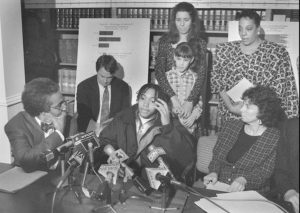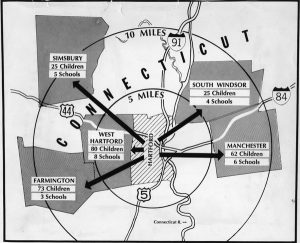Background:
In 1989, Milo Sheff, a fourth-grade student at Annie Fisher Elementary School in Hartford, and 10 others sued the state of Connecticut in order to unhinge the inequality between the “level of education provided to students in Hartford public schools and that available to children in surrounding suburban districts (“History of Sheff v. O’Neill”). The Sheff plaintiffs sued on behalf of Black, Latinx, and white public schools students in Hartford, Connecticut. They argued that these students were being denied an equal education compare to their counterparts in suburban school districts due to the racial segregation and the economic disparities between Hartford schools and those in the nearby suburbs. This was a landmark civil rights case that sought to create the conditions for all children to live and prosper in an increasingly diverse, globally connected world. I would argue that this case has set a standard of diversity initiatives in Connecticut for the foreseeable future that we still follow today.
Sheff v. O’Neill Decision:

Milo Sheff, April 1995, Milo Sheff, center, talks during a press conference. Source: Albert Dickson / Hartford Courant.
In a 4-3 decision, the Connecticut Supreme Court ruled in favor of Sheff. In their ruling they said, “the state had an affirmative obligation to provide Connecticut’s school children with an equal educational opportunity” (Sheff v. O’Neill). They believed that this right to access public education could not and should not be impaired by racial/ethnic isolation. They elaborated on their ruling by concluding that school districting based upon town and city boundary lines is unconstitutional. This decision set a course of slow progress, and changes that would change the Hartford Education System forever.
Outcomes from Decision:

Map of school busing and integration in the greater Hartford area, 1966 – Hartford Public Library, Hartford History Center, Hartford Times Collection
As a result, from the court’s rulings, the Connecticut State Legislature passed legislation in 1997, encouraging “voluntary actions towards racial integration”. This act included other measures including a requirement for the Connecticut Department of Education to come up with a five-year plan to eliminate inequalities between school districts. However, due to the looseness of the agreement and the use of non-binding language, change was slow and, in some cases, nonexistent. In 2002, the Sheff plaintiffs returned unhappy, as the changes they believed would happen from the court decision did not happen within those 5-6 years. The governor and plaintiffs agreed on a Phase 1 that required the state to spend 45 million over the next four years to establish eight additional magnet schools in Hartford. This out-of-court agreement also required the state to increase the number of Hartford students attending integrated schools to 30 percent by 2007. However, the Sheff plaintiffs went back to court as the state failed to increase the percentage to 30 percent. They came to another agreement to a new five-year Phase 2 settlement that required more magnet schools in the Hartford suburbs and expanding the number of openings available for Hartford children through the Open Choice program. In December 2013, another settlement was reached, Phase III that required that 41 percent of Hartford’s minority students been set in “reduced isolation settings…which expanded Open Choice”.
Why revisiting outcomes from Sheff v. O’Neil matter moving forward?
Before this case, the Hartford education system was severely flawed and struggled in many aspects. Public schooling was not performing at the level that they should, and it was affecting future generations who came out of an underwhelming public-school experience. When we take a closer look at the actual agreement’s intent, there was an expectation to see a promising future with these guidelines. However, that has not turned out to be 100 percent true. Many students of color — including about 30 percent of African-American and 22 percent of Latino students in Connecticut —still attend schools that are 90-100 percent minority (“Sheff v. O’Neill”). The agreements created more schools (magnet schools) yet it did not directly address the old public schools in enough depth and detail that would ensure that every student would be on the same playing field. Another issue was the implementation of school choice. For example of 87 percent of students from Hartford that apply to the program, only 42 percent of these students can actually enrolled through a lottery system (Kennedy). This adds yet another barrier/layer that restrict and funnel a selected number of students to have access to these educational opportunities. The way the lottery system is set up there is no guaranteed that the students’ choice is going to be respected. Students are reduced to a number in a hat. With the emergence and success of magnet schools, we forget the main objective of the Sheff case which is to better the “public school system”. By supporting magnet schools over public school, the state is pumping resources into these schools, and at the same time, leaving behind those 48 percent of students who do not reap the benefits of these magnet schools. This is why work still must be done in order to restructure the public-school system in Hartford. The educational system have left behind a large chunk of the same type of students that Sheff fought for in court.
Bibliography
Connecticut School Finance Project, http://ctschoolfinance.org/resources/sheff-v-oneill
“History of Sheff v. O’Neill.” Sheff Movement, https://sheffmovement.org/history-2/
Kennedy, Taylor. “The Effects of Sheff v. O’Neill on Hartford Schools.” Educ 300 Education Reform Past and Present, 5 May 2017, https://commons.trincoll.edu/edreform/2017/05/the-effects-of-sheff-v-oneill-on-hartford-schools/
“Pictures: Sheff vs. O’Neill.” Courant.com, Hartford Courant, 27 Nov. 2012, https://www.courant.com/education/hc-sheffoneill-pg-photogallery.html.
“Sheff v. O’Neill.” NAACP Legal Defense and Educational Fund, https://www.naacpldf.org/case-issue/sheff-v-oneill/
